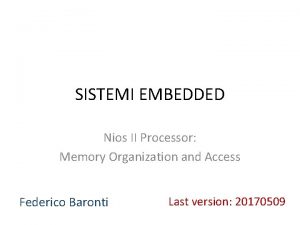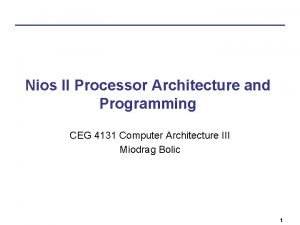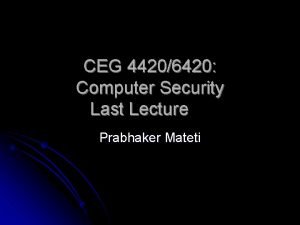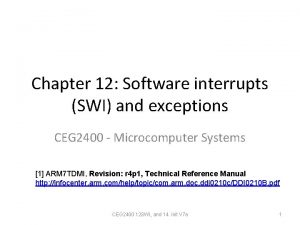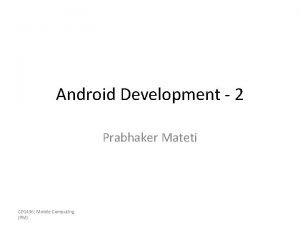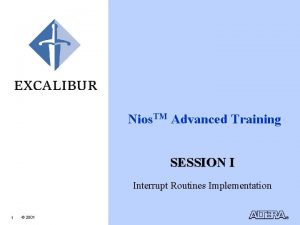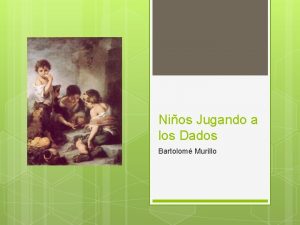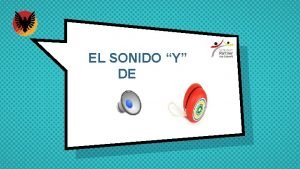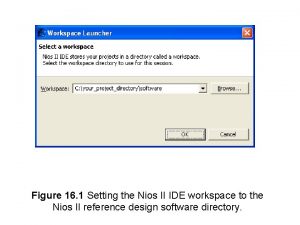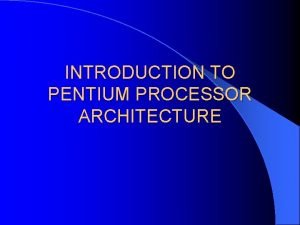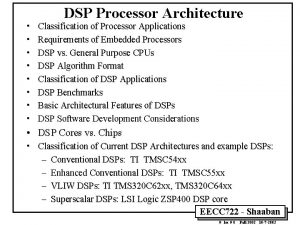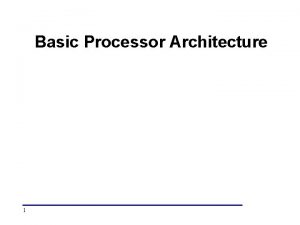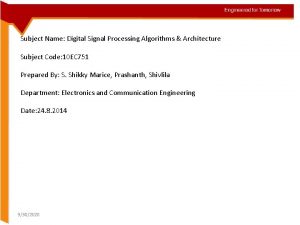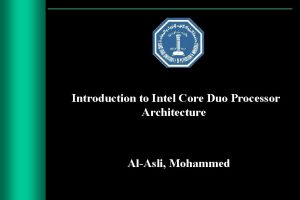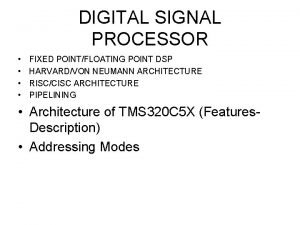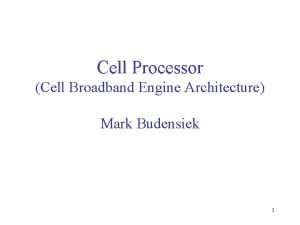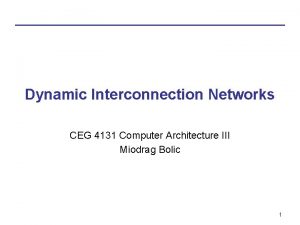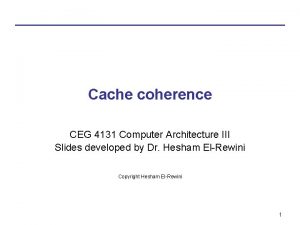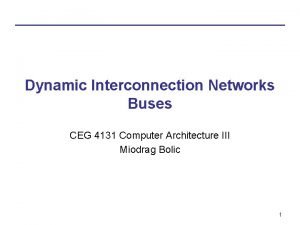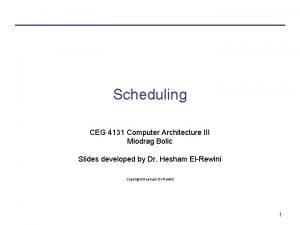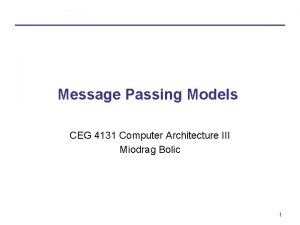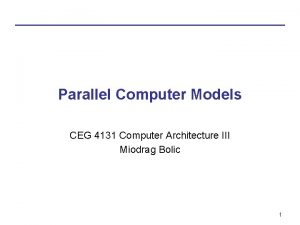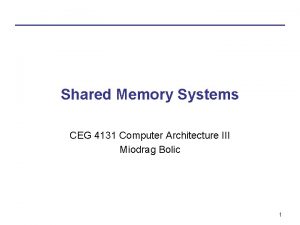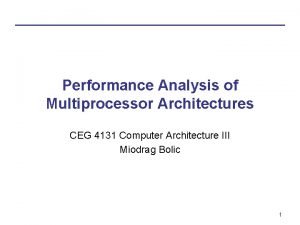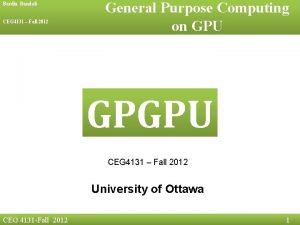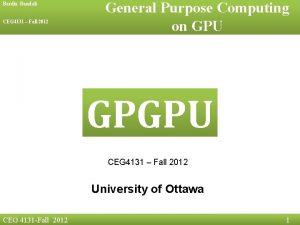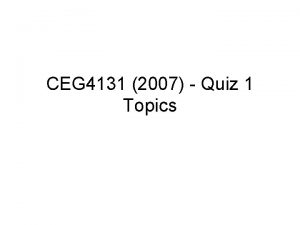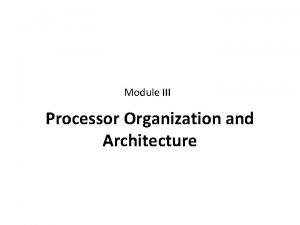Nios II Processor Architecture and Programming CEG 4131


![Stratix EP 1 S 10 [2] 3 Stratix EP 1 S 10 [2] 3](https://slidetodoc.com/presentation_image_h/c9c8c284b76cb43d05f2af5bf5d0be05/image-3.jpg)


![Tri. Matrix™ Memory [1] M 512 Blocks n n Small FIFOs Shift Register Rake Tri. Matrix™ Memory [1] M 512 Blocks n n Small FIFOs Shift Register Rake](https://slidetodoc.com/presentation_image_h/c9c8c284b76cb43d05f2af5bf5d0be05/image-6.jpg)
![Memory Bandwidth Summary Stratix Device Family [1] Device Total RAM Bits M-RAM Blocks EP Memory Bandwidth Summary Stratix Device Family [1] Device Total RAM Bits M-RAM Blocks EP](https://slidetodoc.com/presentation_image_h/c9c8c284b76cb43d05f2af5bf5d0be05/image-7.jpg)

![Logic Element (LE) [2] LUT Chain Input Register Chain Input addnsub Register Control Signals Logic Element (LE) [2] LUT Chain Input Register Chain Input addnsub Register Control Signals](https://slidetodoc.com/presentation_image_h/c9c8c284b76cb43d05f2af5bf5d0be05/image-9.jpg)
![Logic Array Blocks (LAB) [2] Control Signals • 10 LEs • Local Interconnect • Logic Array Blocks (LAB) [2] Control Signals • 10 LEs • Local Interconnect •](https://slidetodoc.com/presentation_image_h/c9c8c284b76cb43d05f2af5bf5d0be05/image-10.jpg)


![NIOS II Overview [3] • Soft IP Core – A soft-core processor is a NIOS II Overview [3] • Soft IP Core – A soft-core processor is a](https://slidetodoc.com/presentation_image_h/c9c8c284b76cb43d05f2af5bf5d0be05/image-13.jpg)

![NIOS II Processor Core [3] 15 NIOS II Processor Core [3] 15](https://slidetodoc.com/presentation_image_h/c9c8c284b76cb43d05f2af5bf5d0be05/image-15.jpg)










![Hardware Abstraction Layer (HAL) [4] • Isolates the application software from hardware modifications. • Hardware Abstraction Layer (HAL) [4] • Isolates the application software from hardware modifications. •](https://slidetodoc.com/presentation_image_h/c9c8c284b76cb43d05f2af5bf5d0be05/image-26.jpg)
![Layers of HAL API [4] • HAL library generatioin: 1. SOPC Builder generates a Layers of HAL API [4] • HAL library generatioin: 1. SOPC Builder generates a](https://slidetodoc.com/presentation_image_h/c9c8c284b76cb43d05f2af5bf5d0be05/image-27.jpg)
![Programming NIOS II Processor [4] • Programming UART – Standard Input, Standard Output routines Programming NIOS II Processor [4] • Programming UART – Standard Input, Standard Output routines](https://slidetodoc.com/presentation_image_h/c9c8c284b76cb43d05f2af5bf5d0be05/image-28.jpg)

- Slides: 29

Nios II Processor Architecture and Programming CEG 4131 Computer Architecture III Miodrag Bolic 1

Presentation Outline • Basic description of Stratix Altera Devices • NIOS II processor architecture – Review pipelining techniques – Review memory access techniques • How to design a system using NIOS II processor 2
![Stratix EP 1 S 10 2 3 Stratix EP 1 S 10 [2] 3](https://slidetodoc.com/presentation_image_h/c9c8c284b76cb43d05f2af5bf5d0be05/image-3.jpg)
Stratix EP 1 S 10 [2] 3

4

5
![Tri Matrix Memory 1 M 512 Blocks n n Small FIFOs Shift Register Rake Tri. Matrix™ Memory [1] M 512 Blocks n n Small FIFOs Shift Register Rake](https://slidetodoc.com/presentation_image_h/c9c8c284b76cb43d05f2af5bf5d0be05/image-6.jpg)
Tri. Matrix™ Memory [1] M 512 Blocks n n Small FIFOs Shift Register Rake Receiver Correlator FIR Filter Delay Line M 4 K Blocks n n Header / Cell Storage n Channelized Functions n n ATM cell–packet processing n Nios Program Memory n Dedicated External Memory Interface M-RAM Packet / Data Storage Nios Program Memory System Cache Video Frame Buffers Echo Canceller Data Storage n n n Look-Up Schemes Packet & Cell Buffering Cache More Bits For Larger Memory Buffering 512 bits per block + parity 4 Kbits per block + parity 512 Kbits per block + parity More Data Ports for Greater Memory Bandwidth 6
![Memory Bandwidth Summary Stratix Device Family 1 Device Total RAM Bits MRAM Blocks EP Memory Bandwidth Summary Stratix Device Family [1] Device Total RAM Bits M-RAM Blocks EP](https://slidetodoc.com/presentation_image_h/c9c8c284b76cb43d05f2af5bf5d0be05/image-7.jpg)
Memory Bandwidth Summary Stratix Device Family [1] Device Total RAM Bits M-RAM Blocks EP 1 S 10 920, 448 1 EP 1 S 20 1, 669, 248 EP 1 S 25 M 4 K Blocks M 512 Blocks Maximum Bandwidth (Mbps) 60 94 1, 245, 024 2 82 194 2, 096, 928 1, 944, 576 2 138 224 2, 894, 400 EP 1 S 30 3, 317, 184 4 171 295 3, 750, 192 EP 1 S 40 3, 423, 744 4 183 384 4, 384, 800 EP 1 S 60 5, 215, 104 6 292 574 6, 762, 528 EP 1 S 80 7, 427, 520 9 364 767 8, 784, 720 7

8
![Logic Element LE 2 LUT Chain Input Register Chain Input addnsub Register Control Signals Logic Element (LE) [2] LUT Chain Input Register Chain Input addnsub Register Control Signals](https://slidetodoc.com/presentation_image_h/c9c8c284b76cb43d05f2af5bf5d0be05/image-9.jpg)
Logic Element (LE) [2] LUT Chain Input Register Chain Input addnsub Register Control Signals cin data 1 data 2 data 3 (2) Sync Load & Clear Logic 4 -Input LUT D DATA data 4 Row, Column & Direct. Link Routing Local Routing Register Feedback LUT Chain Output Register Chain Output Note: 1) 2) Functional Diagram Only. Please See Datasheet for more Details. Addnsum & data 1 connected via XOR logic 9
![Logic Array Blocks LAB 2 Control Signals 10 LEs Local Interconnect Logic Array Blocks (LAB) [2] Control Signals • 10 LEs • Local Interconnect •](https://slidetodoc.com/presentation_image_h/c9c8c284b76cb43d05f2af5bf5d0be05/image-10.jpg)
Logic Array Blocks (LAB) [2] Control Signals • 10 LEs • Local Interconnect • LAB-Wide Control Signals 4 Local Interconnect 4 4 4 4 4 LE 1 LE 2 LE 3 LE 4 LE 5 LE 6 LE 7 LE 8 LE 9 LE 10 10

Presentation Outline • Basic description of Stratix Altera Devices • NIOS II processor architecture – Review pipelining techniques – Review memory access techniques • How to design a system using NIOS II processor 11

12
![NIOS II Overview 3 Soft IP Core A softcore processor is a NIOS II Overview [3] • Soft IP Core – A soft-core processor is a](https://slidetodoc.com/presentation_image_h/c9c8c284b76cb43d05f2af5bf5d0be05/image-13.jpg)
NIOS II Overview [3] • Soft IP Core – A soft-core processor is a microprocessor fully described in software, usually in an HDL, which can be synthesized in programmable hardware, such as FPGAs. • • • Reduced Instruction Set Computer (RISC) No pipeline, 5 or 6 stages pipeline configurations Full 32 -bit instruction set, data path, and address space 32 general-purpose registers 32 external interrupt sources Access to a variety of on-chip peripherals, and interfaces to off-chip memories and peripherals • Software development environment based on the GNU C/C++ tool chain and Eclipse IDE 13

NIOS II Scalability • Powerful multiprocessing systems can be built 14
![NIOS II Processor Core 3 15 NIOS II Processor Core [3] 15](https://slidetodoc.com/presentation_image_h/c9c8c284b76cb43d05f2af5bf5d0be05/image-15.jpg)
NIOS II Processor Core [3] 15

Implementation • The functional units of the Nios II architecture form the foundation for the Nios II instruction set. • The Nios II architecture describes an instruction set, not a particular hardware implementation. • Trade-offs: – More or less of a feature - amount of instruction cache memory. – Inclusion or exclusion of a feature - the JTAG debug module. – Hardware implementation or software emulation - divider 16

Types of Processors 17

Memory Organization 18

Instruction and Data Cache • Useful for high latency external memories • Cache is direct mapped – Low address bits represent cache line • Use write-though policy – Data is written to external memory as well as cache • Problem – Instruction cache has 32 bytes per cache line – We choose cache size of 1024 bytes – Question: How many bits are needed for the tag 19

Cache Performance Memory I-Cache D-Cache Normalised Performance SDRAM No No 40. 2% SDRAM No Yes 55. 2% SDRAM Yes No 64. 3% SDRAM Yes 96. 4% On. Chip No No 100. 0% On. Chip No Yes 98. 0% On. Chip Yes No 110. 2% On. Chip Yes 105. 6% Performance relative to on chip RAM with no Cache running dhry. c modified for unbuffered I/O 20

Tightly Coupled Memory • • • Fast data buffers Fast sections of code Fast interrupt handler Critical loop Constant access time; guaranteed not to have arbitration delays • Up to 4 tightly coupled memories • Software Guidelines – Software accesses tightly-coupled memory addresses just like any other addresses. – Cache operations have no effect when targeting tightly-coupled 21

Pipelining • Static branch prediction is implemented using the branch offset direction; – a negative offset is predicted as taken – a positive offset is predicted as not-taken 22

23

Presentation Outline • Basic description of Stratix Altera Devices • NIOS II processor architecture – Review pipelining techniques – Review memory access techniques • How to design a system using NIOS II processor 24

25
![Hardware Abstraction Layer HAL 4 Isolates the application software from hardware modifications Hardware Abstraction Layer (HAL) [4] • Isolates the application software from hardware modifications. •](https://slidetodoc.com/presentation_image_h/c9c8c284b76cb43d05f2af5bf5d0be05/image-26.jpg)
Hardware Abstraction Layer (HAL) [4] • Isolates the application software from hardware modifications. • Applications are device-independent because they abstract information from such systems as: – Character mode devices: UART core, JTAG UART core, LCD display controller – Flash memory devices – Timer devices – DMA controller core – Ethernet MAC/PHY Controller • HAL application program interface (API) is integrated with the ANSI C standard library. 26
![Layers of HAL API 4 HAL library generatioin 1 SOPC Builder generates a Layers of HAL API [4] • HAL library generatioin: 1. SOPC Builder generates a](https://slidetodoc.com/presentation_image_h/c9c8c284b76cb43d05f2af5bf5d0be05/image-27.jpg)
Layers of HAL API [4] • HAL library generatioin: 1. SOPC Builder generates a hardware system 2. Nios II IDE generates a custom HAL system library to match the hardware configuration • • Changes in the hardware configuration automatically propagate to the HAL device driver configuration NIOS II is programmed in C 27
![Programming NIOS II Processor 4 Programming UART Standard Input Standard Output routines Programming NIOS II Processor [4] • Programming UART – Standard Input, Standard Output routines](https://slidetodoc.com/presentation_image_h/c9c8c284b76cb43d05f2af5bf5d0be05/image-28.jpg)
Programming NIOS II Processor [4] • Programming UART – Standard Input, Standard Output routines in C -------------------------#include <stdio. h> #include <string. h> int main (void) { char* msg = “hello world”; FILE* fp; fp = fopen (“/dev/uart 1”, “w”); if (fp) { fprintf(fp, “%s”, msg); fclose (fp); } return 0; } -------------------------28

References 1. Altera Corp. , Stratix & Stratix II Module 3: Using Tri. Matrix Memories, 2004 2. Altera Corp. , Stratix Module 2: Logic Structure & Multi. Track Interconnect, 2004. 3. Altera Corp. , Nios II Processor Reference Handbook, 2005. 4. Altera Corp. , Nios II Software Developer's Handbook, 2005. 29
 Nios ii processor reference handbook
Nios ii processor reference handbook Nios ii architecture
Nios ii architecture Ceg security agency
Ceg security agency Software interrupts
Software interrupts Ceg vs nfc
Ceg vs nfc Apa kang diarani pranatacara iku
Apa kang diarani pranatacara iku Aztransfer ceg
Aztransfer ceg Nios obe level b books
Nios obe level b books Derechos de los niños cuales son
Derechos de los niños cuales son Actividades para nios
Actividades para nios Nios tm
Nios tm Hola nios
Hola nios Nios jugando
Nios jugando Cartelera cct
Cartelera cct Hola
Hola Hola nios
Hola nios Hola queridos
Hola queridos Frases con ya ye yi yo yu
Frases con ya ye yi yo yu Juegos de teatro
Juegos de teatro Hola nios
Hola nios Hola nios
Hola nios Hola nios
Hola nios Nios ii ide
Nios ii ide 1993 pentium processor
1993 pentium processor Harvard architecture
Harvard architecture Basic processor architecture
Basic processor architecture Dsp algorithms and architecture
Dsp algorithms and architecture Intel core processor architecture
Intel core processor architecture Digital signal processor architecture
Digital signal processor architecture Cell broadband engine architecture
Cell broadband engine architecture
